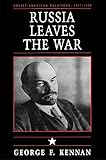Soviet-American Relations, 1917-1920, Volume I : Russia Leaves the War / George Frost Kennan.
Material type: TextPublisher: Princeton, NJ : Princeton University Press, [2021]Copyright date: ©1990Description: 1 online resource (513 p.)Content type:
TextPublisher: Princeton, NJ : Princeton University Press, [2021]Copyright date: ©1990Description: 1 online resource (513 p.)Content type: - 9781400843824
- HISTORY / Russia & the Former Soviet Union
- Adams, John Quincy
- Advisory Commission of Railway Experts
- Amur Expedition
- Archangel, map
- Associated Press
- Baltic States
- Belgium
- Bryant, Louise
- Bykov
- Carter, Allen
- Caucasus
- Changchun
- Crane, Richard
- Decree on Peace
- Don Cossack region
- Dvinsk
- Estonia
- Foch, Marshal Ferdinand
- Gatchina
- Gibson
- Hagedorn, Hermann
- Hard, William
- Hucher, General
- Imbrie, American Vice Consul
- Inter-Allied Conferences, Paris
- Irkutsk
- Jenkins, Douglas, American Consul
- Karakhan, Leo
- Kharkov, map
- Krasnoyarsk
- Kurland
- Larson, Cedric
- Lippmann, Walter
- Lithuania
- Manikovski, General
- Masaryk, Thomas
- Miller, David Hunter
- Nagasaki
- Narva
- New York Evening Post
- Novoye Vremye
- Novy Mir
- Omsk
- Outlook, The
- Palestine
- Persia
- Platten, Fritz
- Poland
- Pouren
- Pri-Amur
- Rudewitz
- 327.47073 23
- E183.8.R9 K4 1989eb
- online - DeGruyter
| Item type | Current library | Call number | URL | Status | Notes | Barcode | |
|---|---|---|---|---|---|---|---|
 eBook
eBook
|
Biblioteca "Angelicum" Pont. Univ. S.Tommaso d'Aquino Nuvola online | online - DeGruyter (Browse shelf(Opens below)) | Online access | Not for loan (Accesso limitato) | Accesso per gli utenti autorizzati / Access for authorized users | (dgr)9781400843824 |
Frontmatter -- Preface -- CONTENTS -- ILLUSTRATIONS -- PROLOGUE -- I. THE IMMEDIATE HISTORICAL BACKGROUND -- II. PERSONALITIES -- III. FIRST REACTIONS -- IV. THE SOVIET APPROACH TO AN ARMISTICE -- V. FIRST PROBLEMS OF "CONTACT" WITH THE SOVIET AUTHORITIES -- VI. ALLIED DELIBERATIONS IN PARIS -- VII. WILSON AND THE WAR AIMS -- VIII. LANSING AND THE RECOGNITION PROBLEM -- IX. THE PROBLEM OF ANTI-BOLSHEVIK RUSSIA -- X. THE KALPASHNIKOV AFFAIR -- XI. THE FIRST BREST-LITOVSK CRISIS -- XII. THE FOURTEEN POINTS -- XIII. SIBERIA-THE BACKGROUND -- XIV. SIBERIA-THE FIRST EXCHANGES -- XV. JAPAN ASKS FOR A FREE HAND -- XVI. THE DIAMANDI INCIDENT -- XVII. THE CONSTITUENT ASSEMBLY -- XVIII. BREST-LITOVSK AND THE AMERICANS -- XIX. WASHINGTON AND THE PROBLEM OF "CONTACTS" -- XX. COMPLICATIONS IN PETROGRAD -- XXI. THE BREAKUP IN PETROGRAD -- XXII. THE SISSON PAPERS -- XXIII. SIBERIA AND THE FINAL BREST-LITOVSK CRISIS -- XXIV. ROBINS AND RATIFICATION -- APPENDIX -- ACKNOWLEDGMENTS -- SELECTED BIBLIOGRAPHY -- INDEX
restricted access online access with authorization star
http://purl.org/coar/access_right/c_16ec
Winner of the Pulitzer Prize in History, the National Book Award for Nonfiction, the George Bancroft Prize, and the Francis Parkman Prize, this absorbing volume explores the complexities of the Soviet-American relationship between the November Revolution of 1917 and Russia's final departure in March 1918 from the ranks of the warring powers.These four months, which witnessed the Bolshevik Revolution and Russia's departure from the warring powers, set the stage for future relations between the two emerging superpowers. Volume 2 of Soviet American Relations, entitled The Decision to Intervene (Princeton, 1958), explored U.S. intervention in northern Russia and Siberia between 1918 and 1920.The distinguished scholar and public servant George F. Kennan opens the way to an understanding not only of these events but of the subsequent pattern of Soviet-American relations and the complex process of international diplomacy generally. Kennan became the U.S. government's key analyst of the Soviet Union after a two-year stint in the Foreign Service there (1944-1946), which had been preceded by service in the American embassy in Moscow before World War II. His "long telegram" to his superiors at the State Department, written in 1946 and published a year later in revised form in Foreign Affairs as the famous "X" article, was perhaps the most influential statement in the early years of the Cold War. After leaving the Foreign Service, Kennan joined the faculty at the School for Historical Studies at the Institute for Advanced Study in Princeton, where he wrote Russia Leaves the War and subsequent books.
Mode of access: Internet via World Wide Web.
In English.
Description based on online resource; title from PDF title page (publisher's Web site, viewed 30. Aug 2021)


